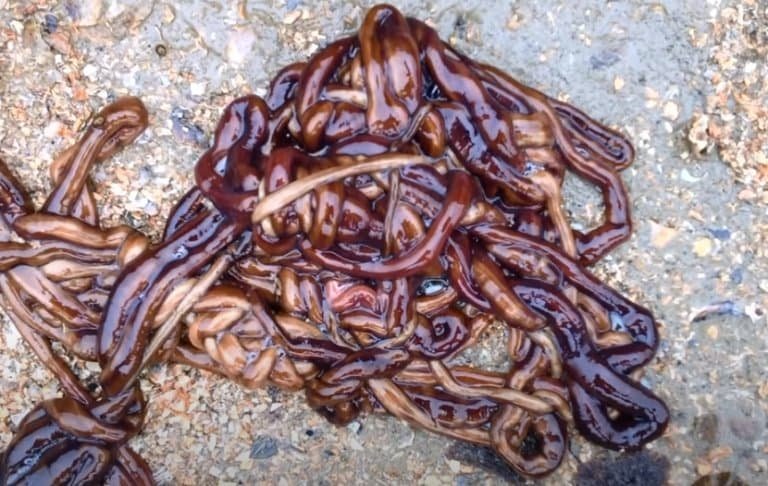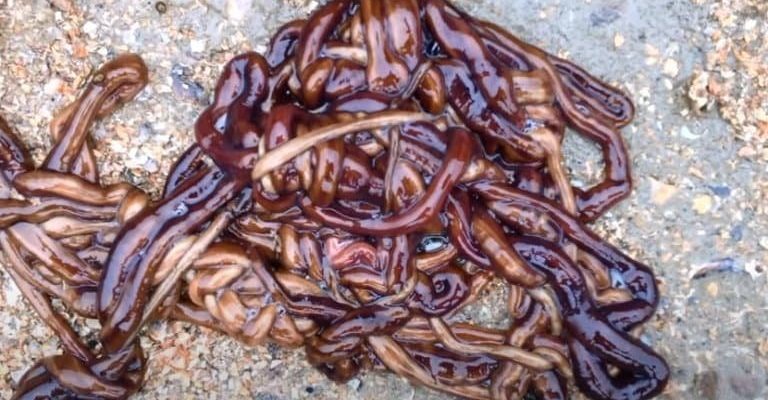
Think of the bootlace worm like a magician pulling off an impossible trick. Instead of having a stomach to break down its meals, it has developed a unique process to handle digestion. This worm is a prime example of nature’s creativity, showing how organisms can adapt in surprising ways. Let’s dig into this remarkable creature’s digestive methods and learn just how it manages to thrive on a diet that would stump most animals!
What Are Bootlace Worms?
Bootlace worms, or *Lineus longissimus*, are part of the ribbon worm family. They’re mostly found in shallow waters along the coast of the UK and Ireland. These worms are known for their incredible length, earning them the title of one of the longest animals on the planet. Imagine a piece of spaghetti that just keeps going… and going!
What’s remarkable about bootlace worms is their body structure. They have a simple body plan that lacks complex organs like a traditional stomach. Instead of a closed digestive system, they possess a gastrovascular cavity, which acts more like a pouch than a stomach. This gives them flexibility in how they digest their food.
In terms of diet, bootlace worms primarily feast on small invertebrates such as crustaceans and mollusks. They usually catch their prey using a unique organ called a proboscis, which they can extend to capture unsuspecting meals. Picture a slender, stretchy tongue—fast and efficient!
The Digestive Process Explained
Now, let’s break down how bootlace worms actually digest their food. Since they don’t have a true stomach, they have to rely on other methods to process their meals. It all starts when they capture their prey with that nifty proboscis. Here’s how it generally works:
1. Capturing the Prey: Once the bootlace worm has snagged its meal, it brings it into its body using its proboscis.
2. Enzymatic Breakdown: After that, enzymes come into play. These enzymes are secreted into the gastrovascular cavity, where they begin breaking down the food outside the worm’s body. Think of it like marinating meat before cooking—it allows for more effective breakdown and absorption.
3. Absorption: After the food is broken down into simpler nutrients, the bootlace worm absorbs these nutrients through its skin into its bloodstream. This is a rather efficient way to get nourishment without needing a stomach!
Isn’t it amazing how these worms have adapted to thrive without what we’d consider standard digestive organs?
The Role of Enzymes in Digestion
Speaking of enzymes, they play a huge role in how bootlace worms digest their meals. Enzymes are biological catalysts that speed up chemical reactions in living organisms. In the case of our slimy friends, they break down complex food particles into simpler molecules.
The specific enzymes bootlace worms use can vary based on what they eat. For example, if they’re munching on crustaceans, they might produce enzymes that specifically target the chitin in those shells. Here’s why that’s important:
– Efficiency: By tailoring their enzymatic response to the type of prey, bootlace worms maximize nutrient absorption. This means they get more bang for their buck, so to speak.
– Versatility: Without a dedicated stomach, this method allows them to adapt to diverse food sources. A worm that can switch its digestive approach based on diet is a successful worm, for sure!
This unique process is a great illustration of how evolution finds creative solutions to challenges. What might seem like a disadvantage—lacking a stomach—turns out to be a strength in their aquatic environment.
Adaptations in Marine Environments
Bootlace worms are masters of adaptation. Living in marine environments comes with its own set of challenges, and these worms have developed several traits to thrive:
– Hydrodynamic Bodies: Their long, slender shape helps them navigate through water with ease. This is particularly useful when they’re hunting or avoiding predators.
– Tolerance to Different Conditions: Bootlace worms can thrive in a range of habitats, from muddy bottoms to sandy substrates. Their adaptability allows them to exploit various food sources.
– Camouflage: Many bootlace worms can blend into their surroundings, hiding from predators while waiting for the right moment to strike.
These adaptations aren’t just neat; they’re crucial for survival. The bootlace worm’s unique digestion strategy ties into its overall adaptability in a world full of challenges.
Why This Matters in the Ecosystem
Understanding how bootlace worms digest food without a true stomach opens up fascinating insights into marine ecosystems. These worms play a key role in the ocean’s food web. Here’s why it matters:
– Nutrient Cycling: By breaking down prey efficiently, bootlace worms help release nutrients back into the environment, enriching the ecosystem and supporting a variety of marine life.
– Prey for Predators: These worms themselves are food for larger creatures, such as fish and birds. Their unique digestive strategies can influence the health and population of those predator species.
– Research Opportunities: Studying how bootlace worms manage to digest food without a stomach provides scientists with clues about evolution, adaptability, and the challenges organisms face in different habitats.
When we appreciate the vital role of bootlace worms, it pushes us to recognize the interconnectedness of life in our oceans. Each species plays its part in a larger story.
The bootlace worm is a remarkable example of nature’s ingenuity. By digesting prey without a traditional stomach, it highlights how various adaptations can help organisms thrive in their environments. The next time you think about digestion, remember that there’s more than one way to process a meal!
As we continue to explore the wonders of the natural world, let’s take a moment to appreciate these unique creatures. They remind us that even in the depths of the ocean, there are incredible stories of survival and adaptation waiting to be discovered. Whether you dive into the ocean or just peek from the shore, the bootlace worm’s tale is one of resilience and innovation.

